|
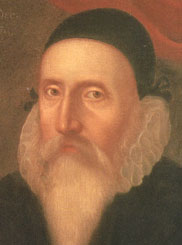 John Dee (1547-1608)
John Dee (1547-1608)
[Ashmolean Museum]
|
One of the arguments used by anti-masons to support their claim that Freemasonry is satanic is to refer to the masonic use of the pentagram. The short answer to this accusation is that the pentagram has no masonic significance beyond its association with Pythagoras and the Golden Ratio, and is not mentioned in any published masonic ritual.
|
|
|
|
The pentagram:
modern usage
(Appendix II)
|
 |
 |
 |
 Mediaeval and Renaissance authors of hermetic manuscripts and texts made use of a large number of figures, sigils, seals and designs based on the iconography of alchemy, astrology and magic squares. The pentagram does not appear to have been a central theme or image, being restricted mainly to a warding device. Mediaeval and Renaissance authors of hermetic manuscripts and texts made use of a large number of figures, sigils, seals and designs based on the iconography of alchemy, astrology and magic squares. The pentagram does not appear to have been a central theme or image, being restricted mainly to a warding device.
 The twentieth century preoccupation with identifying the pentagram with magic appears to be the result of opinions expressed by Éliphas Lévi and Aleister Crowley. The images seen below are a selection of modern or contemporary usages. The twentieth century preoccupation with identifying the pentagram with magic appears to be the result of opinions expressed by Éliphas Lévi and Aleister Crowley. The images seen below are a selection of modern or contemporary usages.
|
 |
 |
 |
 |
 |  |  |
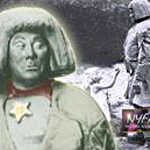
| |
1. This early-twentieth century mainstream usage of a five-pointed star was not derived from the sixteenth century story that the film was based on. Paul Wegener’s (1874-1948) first Golem film, Der Golem, was made in 1914, and Der Golem und die Tanzerin followed in 1917. In 1920, Der Golem: Wie er in die Welt Kam (The Golem: or How He Came into the World) was released. The movies retell the legend of a clay man created by Rabbi Löw during the sixteenth century and brought to life by an antique dealer who acquired the statue from an excavated synagogue in Prague. The story ties in with Der Golem of 1914 as a prequel set in 1580 Prague as Rabbi Löw creates the clay man to protect the Jewish ghetto from the persecution of Emperor Rudolph II.
 Compare this usage of the pentagram with Ingmar Bergman’s use of the hexagram in The Magician (1958) and with Fritz Lang’s Metropolis (1926) in which a large pentagram appears, one point down, behind the chair where the robot is brought to life and a relief pentagram, one point up, is fastened to a door to Rotwang’s house. Whether these usages are thinly veiled antisemitism or valid references to Mediaeval hermeticism is a question for further research. Other examples of the pentagram in film can also be found. Compare this usage of the pentagram with Ingmar Bergman’s use of the hexagram in The Magician (1958) and with Fritz Lang’s Metropolis (1926) in which a large pentagram appears, one point down, behind the chair where the robot is brought to life and a relief pentagram, one point up, is fastened to a door to Rotwang’s house. Whether these usages are thinly veiled antisemitism or valid references to Mediaeval hermeticism is a question for further research. Other examples of the pentagram in film can also be found.
|
 |
 |  |  |

| |
2. As a counterpoint to the argument that early twentieth century use of the pentagram masked a thinly veiled antisemitism, compare this example of National Socialist art. The painting, Upper Austrian Farm Family by Anton Lutz depicts the usual themes of farming, labour, family and children but is noteworthy here for the additional element of a pentagram on the crib footboard. In this context it reflects a common usage among the peasantry who viewed the pentagram as a warding sign, protecting from evil.
 While Der Golam, as noted above, used the pentagram as a magical, animating, sigil, another later film of the period, Murnau’s 1926 Faust neglects the pentagram entirely.
Art in the Third Reich, Berthold Hinz. trans. Robert and Rita Kimber. New York : Pantheon Books, 1979. hb 268pp. p. 93. [Zentralinstitut für Kunstgeschichte, Munich.]
While Der Golam, as noted above, used the pentagram as a magical, animating, sigil, another later film of the period, Murnau’s 1926 Faust neglects the pentagram entirely.
Art in the Third Reich, Berthold Hinz. trans. Robert and Rita Kimber. New York : Pantheon Books, 1979. hb 268pp. p. 93. [Zentralinstitut für Kunstgeschichte, Munich.]
|
 |
 |  |  |

| |
3. This late twentieth century usage identifies the pentagram as an Islamic Star.
Yaacov Agam (b. 1928). Star of Peace. 1994. Oil on aluminum. Collection of the artist. "In this work, a Star of David and an Islamic Star together create a Star of Peace." Jewish Art, Grace Cohen Grossman. Los Angeles : Hugh Lauter Levin Associates, Inc., 1995. p. 303.
|
 |
 |  |  |
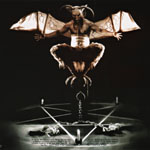
| |
4. Used as an icon in promoting heavy metal rock music since the 1960s, here the satanic imagery is parodied on the cover of a comedy album.
Tenacious D (Jack Black and Kyle Gass), Copyright 2001 Sony Music Entertainment Inc., Toronto, Ontario (Sony Music).
|
 |
 |  |  |

| |
5. Homestar Runner, the title character of an online animated cartoon found at <www.homestarrunner.com/>, is usually shown wearing a five-pointed star on his shirtfront, This frame from "In Search of the Yello Dello" shows a pentagram.
Home Star Runner. Written, directed and produced by them Brothers Chaps. Voices by Matt and Missy. A Homestar Runner Cartoon. 2003.
|
 |
 |  |  |

| |
6. Texas Rangers badge. The original of this badge was carved from a Mexico peso coin. Photographs taken in the 1870s through the 1920s show that there was a great variety of badges. Conceived by freemason Stephen F. Austin (1793-1836) in 1823, the Texas Rangers were established in 1835 and became part of the Texas Department of Public Safety in 1935.
The circle-star badge is believed to be related to the adoption of the state seal. A letter written by Charles B. Stewart in 1835, now in the Texas State Archives, states that he used a pearl button in the shape of a five-pointed star to make an impression in wax as the first state seal. This was during the convention of Texans who met to proclaim their independence from Mexico. They also sent three men, Sam Houston, John Cameron and John Forbes to parlay, with the Indians. The impromptu-wax seal created by Stewart, who served as secretary of the convention, was on their commissions.
 As Stewart stated it in his letter of 1835, the star is "A fitting emblem of a new star arisen-in the galaxy of states (nations)." Thus, marked the beginning of a five-pointed star officially accepted in the flag of the "Lone Star State," and the first state law enforcement badge.
See texasranger.org/history/HistoricBadges.htm [2004/12/03] As Stewart stated it in his letter of 1835, the star is "A fitting emblem of a new star arisen-in the galaxy of states (nations)." Thus, marked the beginning of a five-pointed star officially accepted in the flag of the "Lone Star State," and the first state law enforcement badge.
See texasranger.org/history/HistoricBadges.htm [2004/12/03]
|
 |
 |  |  |

| |
7.Contemporary interpretations of witchcraft: while the text makes only one mention of a pentagram as a decorative element on a magical cape, the illustrator incorporates the five-pointed star into representations of a cat and goat on page 62; and the pentagram on a cloak on page 95, a pair of gloves on page 96 and on a door frame on page 138. It’s symbolic value or purpose is not explained, and it is always one point ascendant.
Witches,Erica Mann Jong. Illustrated by Joseph A. Smith. New York : Harry N. Abrams, Inc., Publishers, 1997. cf.: Margaret A. Murray, The Witch-Cult in Western Europe. Oxford : Clarendon Press, 1921.
|
 |  |  |
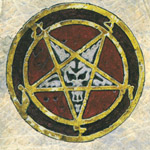
| |
8. The lurid dust jacket illustration for a book on the history of an American satanic coven reinforces the popular misconception promoted by the American Church of Satan, identifying the pentagram with Satan.
Satan’s High Priest a true story. Judith Spencer illust. by Doug Knutson. Pocket Books, 1997. hc ISBN: 0671728008.
|
 |  |  |
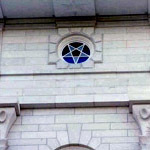
| |
9.
"The Mormon Church has received plenty of criticism regarding the many inverted pentagrams that are displayed on both the exterior and interior of the temple in Nauvoo, Illinois. Several of them are located on the perimeter of the temple and as many as 138 inverted stars can be found in the assembly room. Inverted pentagrams can also be found on the upper walls and embroidered into the curtains of the celestial room."
The Nauvoo Pentagrams, Bill McKeever.
|
 |  |  |
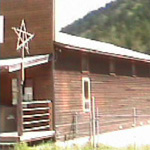
| |
10.
Displayed in 2006 on at least a half-dozen storefronts along the main road through the small farming community of Falkland, BC, are large wooden pentagrams outlined in decorative lights. No explanation is available although, as the lights only outline the star and do not form the pentagram, they can be assumed to be Christmas decorations.
Photograph from the site administrator's collection.
|
|